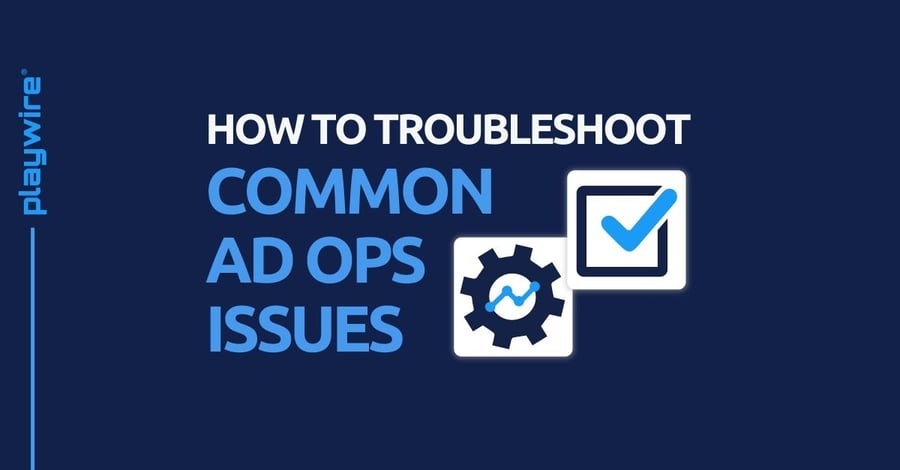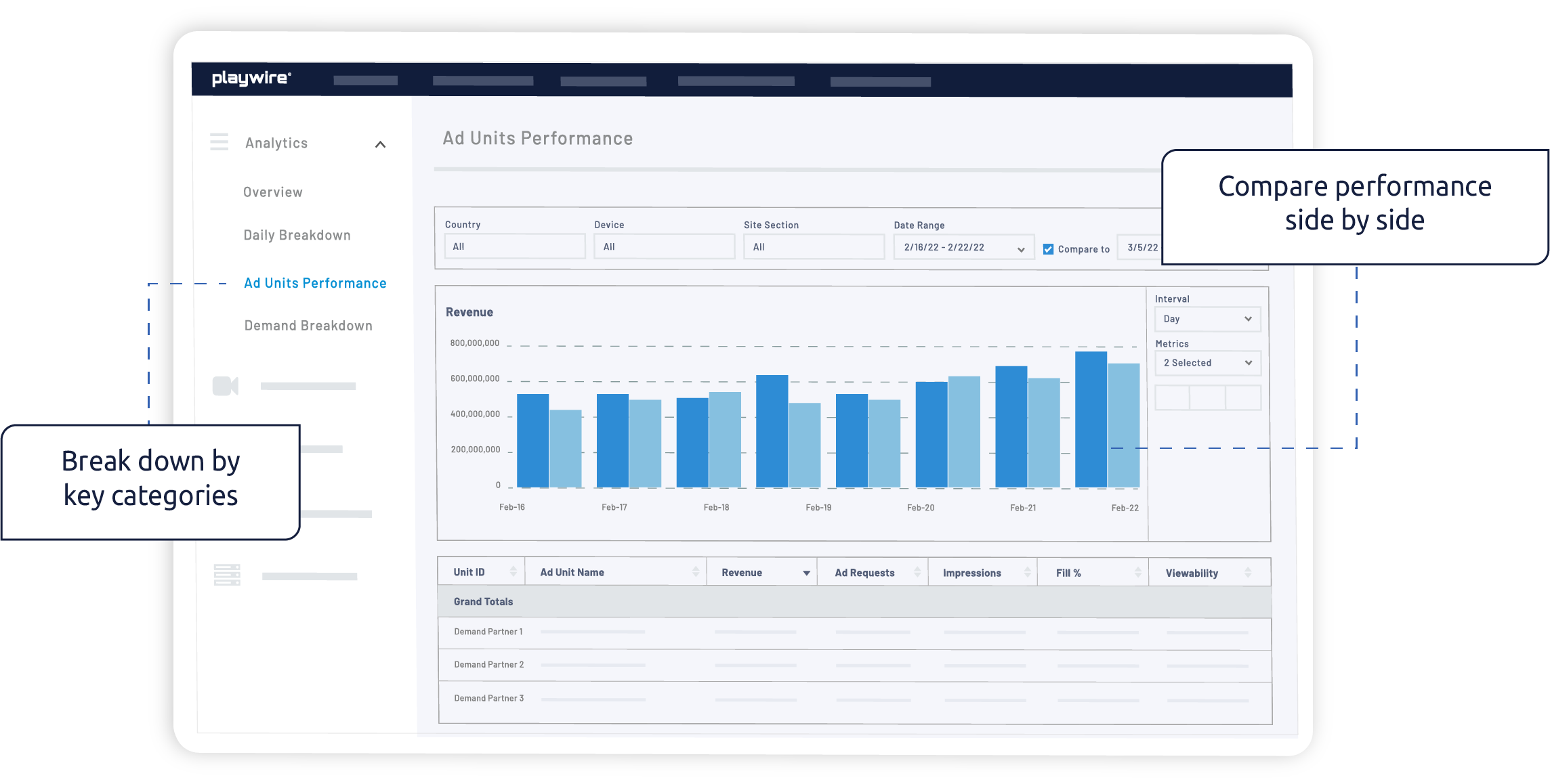How to Troubleshoot Common Ad Ops Issues
August 20, 2023
Editorial Policy
All of our content is generated by subject matter experts with years of ad tech experience and structured by writers and educators for ease of use and digestibility. Learn more about our rigorous interview, content production and review process here.

Key Points
- There are a variety of common challenges that every ad operations team faces, such as pacing and performance issues, which you can effectively troubleshoot with the right tools and strategic creativity.
- The key to successfully troubleshooting ad ops issues lies in having a clear understanding of how to read campaign metrics as well as continuously monitoring and making adjustments when necessary.
- There are a number of tools across the industry that can help publishers of all sizes run their ad operations including Playwire’s RAMP Platform, which offers a comprehensive set of tools for monitoring ad campaigns to ultimately reduce optimization time and inconsistencies.
What if the world of digital advertising was like a fancy Michelin-starred restaurant?
As a business leader, you’d have the role of Chef de Cuisine, the commander at the pass, watching plates as they leave the kitchen, catching every small detail to make sure your guests receive an unparalleled dining experience.
Ad operations (ad ops) is your kitchen, and your ad campaign is your star dish.
Your ingredients and cookware? Those are your strategy, methods, and ad tech tools that keep the fire going and everything cooking just right.
But, much like a real kitchen, not everything goes to plan.
You can follow the recipe closely, only source the best ingredients, and keep a keen eye on every pot, but inevitably, problems will arise. Sauces scorch, souffles fall flat, and fancy cuts of meat overcook.
In the world of ad ops, these hiccups appear as pacing and performance issues.
But fret not. If you have a good Sous Chef at your side, or in this case, an ad ops partner with all the right expertise, you can tackle these common ad ops issues with ease. So, roll up your sleeves, don your apron, and let’s get your advertising campaign out of the weeds and ready for service.
Can I get a “yes, Chef’?

Understanding the Common Challenges in Ad Ops
There are three primary challenges in the world of ad ops:
- Performance issues
- Pacing issues
- Ad yield issues
With most Americans seeing 4,000 to 10,000 advertisements per day, it's important to get these in balance.
As noted above, troubleshooting ad ops issues effectively, like fixing a recipe, requires the right tools and a dash of culinary creativity. However, identifying these common problems is the very first step.
First, let’s tackle pacing.
Identifying Ad Pacing Issues
Just as you would want a curated five-course menu to come out at a comfortable pace for diners, you want the rate of digital ads served and impressions they create over the lifetime of the campaign to hit a comfortable and expected pace as well.
Pacing makes sure you serve each course in perfect sequence, each dish complimenting the next — all while leaving guests hungry for the next plate. However, despite your best efforts to accommodate everyone’s pace, some guests may eat too quickly, while others may eat too slowly, throwing off the kitchen's rhythm.
The same can occur within the online advertising kitchen. In ad ops, pacing issues can stem from several sources:
- Ads being served too quickly
- Depletion of ad inventory
- Ads not being served quickly enough to reach ad campaign goals
If you’re seeing any of these issues, you’ve got a pacing problem.
Identifying Ad Performance Issues
On the other hand, you might be facing ad performance issues. Going back to the hypothetical advertising kitchen, now we’re talking about the quality of the dish. It doesn't matter how perfectly timed the dish comes out; if it’s overcooked, underseasoned, and cold, your guests will not be happy.
In ad ops, these performance issues link back to metrics like click-through rate (CTR) or video completion rate (VCR), depending on your campaign management goals.
Imagine you’re serving an exquisite fish dish — with imported salmon from the Faroe Islands, no less, very fancy. Even with all your effort, your guests are returning plates with little less than a nibble taken. Is it too salty? Is the fish not fresh? Are they already full from previous courses?
If your digital ads are not tasting right — meaning they’re not leading to desired engagement or action — then you’ve got a campaign performance issue on your hands.
Identifying Ad Yield Issues
Another common issue that ad ops professionals run into is ad yield management. Inside the kitchen, every second and every measurement counts. The same is true with managing your yield performance of your ad campaigns.
Successful ad yield management is typically measured by two key metrics: Pageview RPMs and Pageview CPMs. Understanding the difference between these two metrics and how to identify changes to each is only step one. Managing and optimizing for these metrics is an entirely different conversation.
Additionally, there are a number of settings that need to be monitored and managed each and every day as they relate to your ad yield including header bidding settings, price floor settings, ad unit placements and settings, ad quality and blocking settings (category and URL blocks), and supply path optimization.
In the kitchen, often the fix for a dry cake is as simple as lowering the temperature or reducing the cooking time. But for yield ops teams, the solution is almost never simple to identify nor is it to implement.
However, with the right yield and ad ops team by your side, you may just be able to perfect your recipe to success.
Learn more about ad yield management by checking out our comprehensive ad yield management e-course.
-- Article Continues Below --
Read The Complete Guide to Ad Ops For Publishers
The Right Ad Ops Tools Make All the Difference
Now that we’ve identified the most common concerns ad ops professionals face, we can dive deeper into resolving them.
Having the right tools can make all the difference — both in a kitchen and in ad ops.
In our high-tech culinary haven, our cutting-edge appliances make troubleshooting a breeze. In ad ops, we (Playwire and our publishers) have RAMP, the secret weapon in the world of digital advertising.
The RAMP Platform: The Ad Ops Tools of Your Dreams
Just like thermometers and other measurement tools, RAMP offers an at-a-glance dashboard for all your campaigns. It’s a birds-eye view of your entire kitchen, letting you know which campaigns are simmering nicely and which ones are about to boil over.
This ingenious tool is like a smart oven. Instead of needing to constantly check your roast, eyeing the temperature, and adjusting the racks, it tells you when your roast is perfectly cooked.
In the case of ad ops, RAMP is unique in that it keeps you up to date on how your campaigns are pacing and performing. It allows you to periodically adjust campaign parameters, ensuring your advertising feast unfolds flawlessly.

RAMP’s automated reports act like recipe books, updating us intraday, telling us which ingredients are working and which aren’t.
These reports allow you to swiftly identify issues and optimize performance. You get to intimately understand the taste preferences of your audience quickly without needing to manually parse through heaps of data.
Manually Troubleshooting Ad Ops Issues
While we are clearly partial to the automation that has been developed within the RAMP Platform Picture, there are of course other, more manual options.
Think of a baker kneading dough by hand versus using an industrial stand mixer. That’s the difference between traditional manual processes, like those that are available through platforms like Google Ad Manager, and an automated approach such as the one developed through RAMP.
In the old-school method, you’re using a wooden spoon and mixing bowl. It’s time-consuming, and the results will probably be inconsistent, but it does get the job done, sort of.
What do we mean by troubleshooting ad ops issues manually? This includes sifting through ad units one by one, identifying problem units by hand, and determining potential fixes all on your own.
With a platform, like RAMP, you have your own robotic pastry chef packed with features, one of which utilizes an API to identify underperforming ad units.
It’s not just Google Ad Manager, either; it’s also the loads of Excel work that follows traditional approaches to ad ops troubleshooting.
Imagine this pile of Excel work as a mound of dirty dishes. RAMP helps cut through the grime with automation, making data processing as easy as loading the dishwasher.
-- Article Continues Below --
Check out our Complete Ad Ops Resource Center
Campaign Metrics: Watching the Right Numbers
Every chef has their favorite ingredients. In the world of digital advertising, these ingredients come in the form of campaign metrics.
Just like some cooks will always fall back on cayenne or turmeric to add some wow to their dishes, different advertisers will prioritize different metrics. These metrics shape the flavor of the campaign.
For example, advertisers may rely more on VCR if they’re running a video campaign, savoring each full view of that video ad. Conversely, another advertiser might have their eyes set on CTR, more interested in the customers who take a bite than want seconds.
As savvy chefs in the ad ops kitchen, we at Playwire understand that just throwing spices in the pot and hoping for the best is a risky strategy. You need to understand which metrics to watch, just like a chef needs to know their ingredients before they start preparing a dish.
The Power of Continuous Monitoring and Precise Adjustments
Every superstar chef knows attention to detail is what separates the okay from the amazing.
They’re constantly checking the oven temperature, adjusting the heat, and perhaps even spinning the tray for even baking — this dance never ends.
For this reason, leveraging a team of ad ops experts, whether that be internal or external, who have access to a comprehensive set of monitoring tools is more often than not the most effective way to approach ad ops management.
Why? Because it’s just as important to have ad ops expertise as it is the tools at your fingertips to effectively make precise ad unit-level optimizations. And, as noted, continuous performance monitoring is really the only way to ensure your campaigns are as perfectly cooked as a Michelin-starred meal.
This is the real key to tackling those pesky ad ops issues, and unfortunately, it’s a heavy lift.
However, with the RAMP Platform, Playwire’s ad ops team can, quite easily, monitor campaign performance, pacing, and yield settings. If a campaign runs behind schedule, we might loosen frequency caps or expand targeting. If ads aren’t performing well, we might decrease frequency caps or tighten things down to limit exposure.
The only way to truthfully measure success is to stay consistent with monitoring. You can’t just change a few things and hope for the best.
That’s the power of Playwire’s RAMP Platform and ad ops experts. Both give your team peace of mind we utilize all the tools built into RAMP in order to monitor and adjust quickly — helping cut down any ad ops issue that may arise.
Mastering Ad Ops: The Playwire Advantage
When it comes to mastering ad ops troubleshooting, the right tools make all the difference.
Just like a good chef is nothing without their knife roll, businesses need to invest in the right ad ops platform to stay ahead and master the art of advertising campaign troubleshooting.
It’s not a one-time event but a continuous state of monitoring and adjustment.
If you want to learn more about the power of RAMP, be sure to connect with the Playwire team today.

-1.png?width=800&height=157&name=1-playwire-logo-primary-2021%20(1)-1.png)




